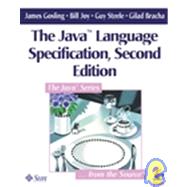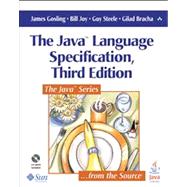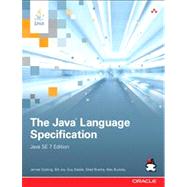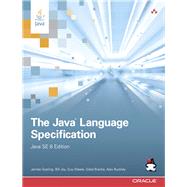Java¿ Language Specification

Java¿ Language Specification
- ISBN 13:
9780201310085
- ISBN 10:
0201310082
- Edition: 2nd
- Format: Paperback
- Copyright: 06/05/2000
- Publisher: Addison-Wesley Professional
- Newer Edition
Note: Supplemental materials are not guaranteed with Rental or Used book purchases.
Extend or Purchase Your Rental at Any Time
Need to keep your rental past your due date? At any time before your due date you can extend or purchase your rental through your account.
Summary
The Java™ programming language was originally called Oak, and was designed for use in embedded consumer-electronic applications by James Gosling. After several years of experience with the language, and significant contributions by Ed Frank, Patrick Naughton, Jonathan Payne, and Chris Warth it was retargeted to the Internet, renamed, and substantially revised to be the language specified here. The final form of the language was defined by James Gosling, Bill Joy, Guy Steele, Richard Tuck, Frank Yellin, and Arthur van Hoff, with help from Graham Hamil ton, Tim Lindholm, and many other friends and colleagues.
The Java programming language is a general-purpose concurrent class-based object-oriented programming language, specifically designed to have as few implementation dependencies as possible. It allows application developers to write a program once and then be able to run it everywhere on the Internet. This book attempts a complete specification of the syntax and semantics of the language. We intend that the behavior of every language construct is specified here, so that all implementations will accept the same programs. Except for timing dependencies or other non-determinisms and given sufficient time and sufficient memory space, a program written in the Java programming language should com pute the same result on all machines and in all implementations.
We believe that the Java programming language is a mature language, ready for widespread use. Nevertheless, we expect some evolution of the language in the years to come. We intend to manage this evolution in a way that is completely compatible with existing applications. To do this, we intend to make relatively few new versions of the language, and to distinguish each new version with a different filename extension. Compilers and systems will be able to support the several ver sions simultannously, with complete compatibility.
Much research and experimentation with the Java platform is already under way. We encourage this work, and will continue to cooperate with external groups to explore improvements to the language and platform. For example, we have already received several interesting proposals for parameterized types. In techni cally difficult areas, near the state of the art, this kind of research collaboration is essential.
We acknowledge and thank the many people who have contributed to this book through their excellent feedback, assistance and encouragement: Particularly thorough, careful, and thoughtful reviews of drafts were provided by Tom Cargill, Peter Deutsch, Paul Hilfinger, Masayuki Ida, David Moon, Steven Muchnick, Charles L. Perkins, Chris Van Wyk, Steve Vinoski, Philip Wadler, Daniel Weinreb, and Kenneth Zadeck. We are very grateful for their extraordinary volunteer efforts.
We are also grateful for reviews, questions, comments, and suggestions from Stephen Adams, Bowen Alpern, Glenn Ammons, Leonid Arbuzov, Kim Bruce, Edwin Chan, David Chase, Pavel Curtis, Drew Dean, William Dietz, David Dill, Patrick Dussud, Ed Felten, John Giannandrea, John Gilmore, Charles Gust, Warren Harris, Lee Hasiuk, Mike Hendrickson, Mark Hill, Urs Hoelzle, Roger Hoover, Susan Flynn Hummel, Christopher Jang, Mick Jordan, Mukesh Kacker, Peter Kessler, James Larus, Derek Lieber, Bill McKeeman, Steve Naroff, Evi Nemeth, Robert O'Callahan, Dave Papay, Craig Partridge, Scott Pfeffer, Eric Raymond, Jim Roskind, Jim Russell, William Scherlis, Edith Schonberg, Anthony Scian, Matthew Self, Janice Shepherd, Kathy Stark, Barbara Steele, Rob Strom, William Waite, Greg Weeks, and Bob Wilson. (This list was generated semi-automatically from our E-mail records. We apologize if we have omitted anyone.)
The feedback from all these reviewers was invaluable to us in improving the definition of the language as well as the form of the presentation in this book. We thank them for their diligence. Any remaining errors in this book---we hope they are few---are our responsibility and not theirs.
We thank Francesca Freedman and Doug Kramer for assistance with matters of typography and layout. We thank Dan Mills of Adobe Systems Incorporated for assistance in exploring possible choices of typefaces.
Many of our colleagues at Sun Microsystems have helped us in one way or another. Lisa Friendly, our series editor, managed our relationship with Addison Wesley. Susan Stambaugh managed the distribution of many hundreds of copies of drafts to reviewers. We received valuable assistance and technical advice from Ben Adida, Ole Agesen, Ken Arnold, Rick Cattell, Asmus Freytag, Norm Hardy, Steve Heller, David Hough, Doug Kramer, Nancy Lee, Marianne Mueller, Akira Tanaka, Greg Tarsy, David Ungar, Jim Waldo, Ann Wollrath, Geoff Wyant, and Derek White. We thank Alan Baratz, David Bowen, Mike Clary, John Doerr, Jon Kannegaard, Eric Schmidt, Bob Sproull, Bert Sutherland, and Scott McNealy for leadership and encouragement.
The on-line Bartleby Library of Columbia University, at URL: http://www.cc.columbia.edu/acis/bartleby/ was invaluable to us during the process of researching and verifying many of the quotations that are scattered throughout this book. Here is one example:
They lard their lean books with the fat of others' works.We are grateful to those who have toiled on Project Bartleby, for saving us a great deal of effort and reawakening our appreciation for the works of Walt Whitman.
---Robert Burton (1576--1640)
We are thankful for the tools and services we had at our disposal in writing this book: telephones, overnight delivery, desktop workstations, laser printers, photocopiers, text formatting and page layout software, fonts, electronic mail, the World Wide Web, and, of course, the Internet. We live in three different states, scattered across a continent, but collaboration with each other and with our reviewers has seemed almost effortless. Kudos to the thousands of people who have worked over the years to make these excellent tools and services work quickly and reliably.
Mike Hendrickson, Katie Duffy, Simone Payment, and Rosa Aim"e GonzSumlez of Addison-Wesley were very helpful, encouraging, and patient during the long process of bringing this book to print. We also thank the copy editors. Rosemary Simpson worked hard, on a very tight schedule, to create the index. We got into the act at the last minute, however; blame us and not her for any jokes you may find hidden therein. Finally, we are grateful to our families and friends for their love and support during this last, crazy, year. In their book The C Programming Language, Brian Kernighan and Dennis Ritchie said that they felt that the C language "wears well as one's experience with it grows." If you like C, we think you will like the Java programming language.
We hope that it, too, wears well for you.
James Gosling--Cupertino, CaliforniaBill Joy--Aspen, Colorado
Guy Steele--Chelmsford, Massachusetts
July, 1996
0201310082P04062001









